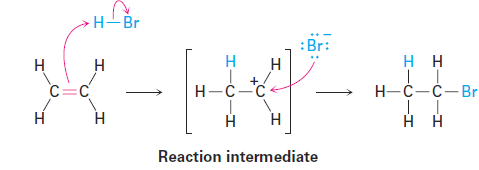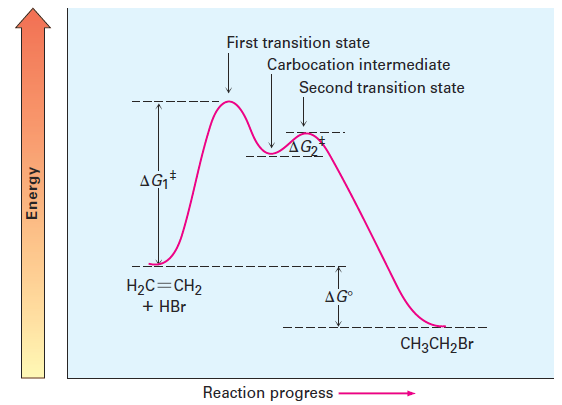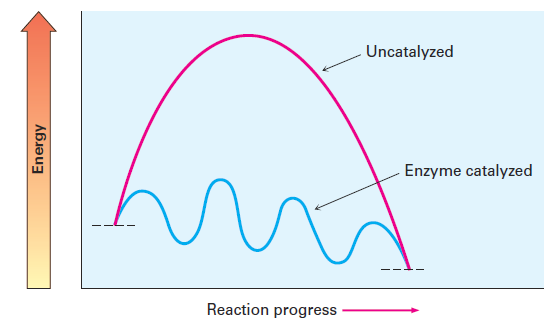


 علم الكيمياء
علم الكيمياء 
 الكيمياء التحليلية
الكيمياء التحليلية 
 الكيمياء الحياتية
الكيمياء الحياتية 
 الكيمياء العضوية
الكيمياء العضوية 
 الكيمياء الفيزيائية
الكيمياء الفيزيائية
 الكيمياء اللاعضوية
الكيمياء اللاعضوية 
 مواضيع اخرى في الكيمياء
مواضيع اخرى في الكيمياء
 الكيمياء الصناعية
الكيمياء الصناعية |
Read More
Date: 14-9-2020
Date: 11-7-2018
Date: 15-5-2017
|
Describing a Reaction: Intermediates
How can we describe the carbocation formed in the first step of the reaction of ethylene with HBr? The carbocation is clearly different from the reactants, yet it isn’t a transition state and it isn’t a final product.

We call the carbocation, which exists only transiently during the course of the multistep reaction, a reaction intermediate. As soon as the intermediate is formed in the first step by reaction of ethylene with H+, it reacts further with Br- in a second step to give the final product, bromoethane.
This second step has its own activation energy ( ΔG°‡), its own transition state, and its own energy change ( ΔG°). We can picture the second transition state as an activated complex between the electrophilic carbocation intermediate and the nucleophilic bromide anion, in which Br- donates a pair of electrons to the positively charged carbon atom as the new C-Br bond just starts to form.
A complete energy diagram for the overall reaction of ethylene with HBr is shown in Figure 1.1. In essence, we draw a diagram for each of the individual steps and then join them so that the carbocation product of step 1 is the reactant for step 2. As indicated in Figure 1.1, the reaction intermediate lies at an energy minimum between steps. Because the energy level of the intermediate is higher than the level of either the reactant that formed it or the product it yields, the intermediate can’t normally be isolated. It is, however, more stable than its two neighboring transition states. Each step in a multistep process can always be considered separately. Each step has its own ΔG°‡ and its own ΔG°. The overall activation energy that controls the rate of the reaction, however, is the energy difference between initial reactants and the highest transition state, regardless of which step it occurs in. The overall ΔG° of the reaction is the energy difference between reactants and final products.

Figure 1.1 An energy diagram for the reaction of ethylene with HBr. Two separate steps are involved, each with its own activation energy (ΔG°‡) and free-energy change ( ΔG°). The overall ΔG°‡ for the complete reaction is the energy difference between reactants and the highest transition state (which corresponds to ΔG1°‡ in this case), and the overall ΔG° for the reaction is the energy difference between reactants and final products.
The biological reactions that take place in living organisms have the same energy requirements as reactions that take place in the laboratory and can be described in similar ways. They are, however, constrained by the fact that they must have low enough activation energies to occur at moderate temperatures, and they must release energy in relatively small amounts to avoid overheating the organism. These constraints are generally met through the use of large, structurally complex, enzyme catalysts that change the mechanism of a reaction to an alternative pathway, which proceeds through a series of small steps rather than one or two large steps. Thus, a typical energy diagram for a biological reaction might look like that in Figure 1.2.

Figure 1.2 An energy diagram for a typical, enzyme-catalyzed biological reaction versus an uncatalyzed laboratory reaction. The biological reaction involves many steps, each of which has a relatively small activation energy and small energy change. The end result is the same, however.



|
|
|
|
اكتشاف تأثير صحي مزدوج لتلوث الهواء على البالغين في منتصف العمر
|
|
|
|
|
|
|
زهور برية شائعة لتر ميم الأعصاب التالفة
|
|
|
|
|
|
جمعيّة العميد وقسم الشؤون الفكريّة تدعوان الباحثين للمشاركة في الملتقى العلمي الوطني الأوّل
|
|
|
|
الأمين العام المساعد لجامعة الدول العربية السابق: جناح جمعية العميد في معرض تونس ثمين بإصداراته
|
|
|
|
المجمع العلمي يستأنف فعاليات محفل منابر النور في واسط
|
|
|
|
برعاية العتبة العباسيّة المقدّسة فرقة العبّاس (عليه السلام) تُقيم معرضًا يوثّق انتصاراتها في قرية البشير بمحافظة كركوك
|